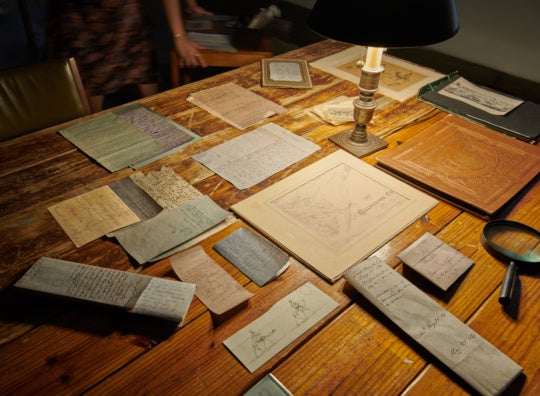
Photographic artist P. Seth Thompson’s Master’s thesis show, The Tannhäuser Gate, at the former Solomon Projects gallery is a deeply personal journey through the history of the development of the artist’s psyche. To understand the manner in which Thompson’s mind has evolved from child to the complex individual that he is today, let me start this review by relating to you some events that not only played a significant role as a recurring theme in The Tannhäuser Gate exhibition, but also in the man’s mind.

On February 6, 1971, astronaut Edgar Mitchell became the sixth man to set foot on the surface of the Moon. The experience was so profound to the Lunar Module pilot, that during the return trip, he experienced a powerful metaphysical epiphany—a Savikalpa samadhi experience. The respected Navy captain also claimed to have communicated with friends back on Earth through a psychic connection during the revelation.
Mitchell, who was well versed in the effectiveness of science, suddenly saw the blinders of his reality pulled back, revealing to him a connection between all things, and has since dedicated his life to the study of quantum physics and ESP phenomena.

15 years later, a six-year-old Thompson watched in tearful astonishment as the Space Shuttle Challenger exploded on live television, instantly killing the crew aboard. All at once, the innocence and naivety of his childhood was replaced with a stark understanding of disaster, tragedy, and death. As he grew older, though, his education in the arts opened his mind to new creative possibilities. And when he came across the story of Captain Mitchell’s usual transformation, the graveness of those facts of life he had learned as a six-year-old boy suddenly diminished, allowing his mind to explore the spaces outside of confirmed scientific reality.

His mind, swelling with surreal, metaphysical potentials, began to see itself as a character archetype. Thompson cast himself in his life narrative as a manifestation of Joseph Campbell’s famous The Hero With A Thousand Faces—stuggling with the help of his love of art, science, and willingness to accept that there are things that we simply do not (or perhaps cannot?) understand.
The Tannhäuser Gate, which incidentally derives its name from the climactic monologue in Ridley Scott’s Blade Runner, is an account of the significant cerebral experiences of Thompson’s life. His photos, digitally (or otherwise) altered, begin with the artist in his youth and move chronologically through his development. As he reaches new breakthroughs in his thinking, the images move from affected portraits to images more abstract, more based in the metaphysical planes of the mind.

Images become increasingly fractured as the story is told, indicating Thompson’s flirtation with the edges of explicable consciousness. Here the universe divides sharply between those sensory paths that human beings are currently able to explore and those that we are, so far, unable to traverse. The story seems to reach its peak of temporal disconnection with Interference, a work based on the imagery surrounding the storied Thomas Young double-slit photon experiment, which sheds the need for a physical form, inviting the viewer to float at once in his or her own inner and outer spaces.
As the collection continues, familiar shapes and silhouettes are reintroduced, once again reconnecting the mind to the tangible realities of our human experience. Visceral patterns that one can almost feel work their way back into the story, demonstrate that while Thompson may have toyed with the infinite that is the mind’s eye, he has survived the journey and come down from that precarious point more human than ever.

But the tragedy of this story walks hand in hand with the themes of self-awareness and humanity. In Blade Runner, Rutger Hauer plays Roy Batty, a supremely intelligent and capable replicant, gifted with all of the emotional complexities of a human being, but doomed to a three-year lifespan. Batty struggles desperately to find a cure for his inherent, terminal condition, but as the hour of his undoing approaches, Batty accepts his fate, lamenting that all of the wondrous things he has seen in his short life are nothing more than moments that will disappear with him in his death, like tears shed in the rain.

And while the sudden death of the Challenger crew, who all no doubt had their minds filled with unbelievable wonder until the very instant of their deaths, offers a dramatic illustration of Batty’s sentiment, Captain Mitchell’s moment of supreme clarity seems to offer a less fatalist viewpoint: while we, as mortals, may only be allotted a brief sliver of time in which to experience reality through our human senses, there is so much that we are incapable of understanding. And when we each pass from this plane of existence into the next, the experience might not be as final as our still-developing minds tend to suggest.
The Tannhäuser Gate paints a vivid image of the human journey—allowing that it might be crushingly finite at the same time that it may also be entirely the opposite, and as such: that we, as simple homo sapiens, might never learn the truth.




